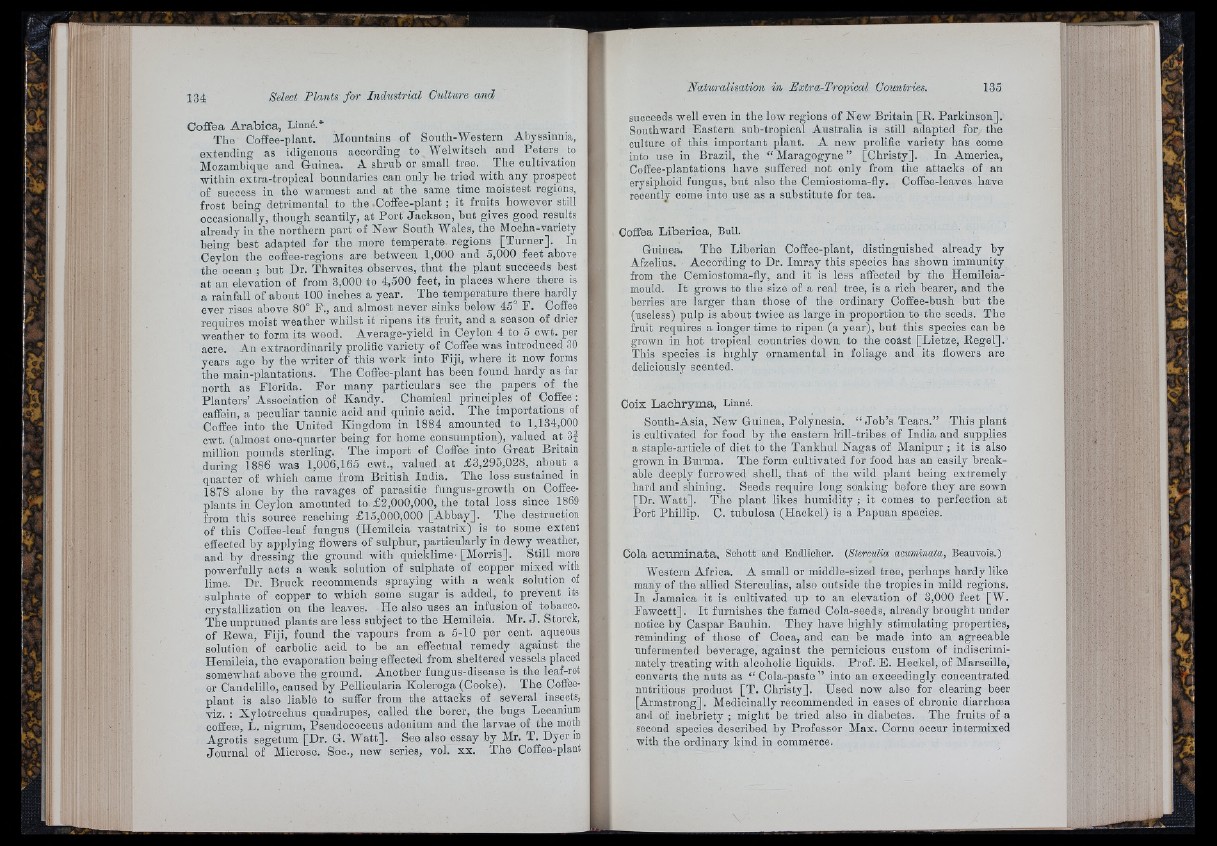
Ooffea A ra b ic a , Linné.*
The Coflee-plant. Mountains of South-Western Abyssinnia,
extending as idigenons according to Welwitsch and Peters to
Mozambique and Guinea. A shrub or small tree. The cultivation
within extra-tropical boundaries can only be tried with any prospect
of success in the warmest and at the same time moistest regions,
frost being detrimental to the Coffee-plant ; it fruits however still
occasionally, though scantily, at P o rt Jackson, but gives good results
already in the northern p a rt of New South Wales, the Mocha-variety
being best adapted for the more temperate regions [Tu rn er]. In
Ceylon the coffee-regions are between 1,000 and 5,000 feet above
the ocean ; but Dr. Thwaites observes, th a t the plant succeeds best
at an elevation of from 3,000 to 4,500 feet, in places where there is
a rainfall of abont 100 inches a year. The temperature there hardly
ever rises above 80° P., and almost never sinks below 45° F. Coffee
requires moist weather whilst it ripens its fruit, and a season of drier
weather to form its wood. Average-yieid in Ceylon 4 to 5 cwt. per
acre. An extraordinarily prolific variety of Coffee was introduced 30
years ago by the writer of this work into Fiji, where it now forms
the main-plautations. The Coffee-plant has been found hardy as far
north as Florida. For many particulars see the papers of the
Planters’ Association of Kandy. Chemical principles of Coffee;
oaffein, a peculiar tannic acid and quinio acid. The importations of
Coffee into the United Kingdom in 1884 amounted to 1,134,000
cwt. (almost one-quarter being for home consumption), valued a t 3 |
million pounds sterling. The import of Coffee into Great Britaia
during 1886 was 1,006,165 cwt., valued at £3,295,028, about a
quarter of which came from British India. The loss sustained ia
1878 alone by the ravages of parasitic fnngus-growth on Coffee-
plants in Ceylon amounted to £2,000,000, the total loss since 1869
from this source reaching £15,000,000 [Abbay]. The destruction
of this Coflee-leaf fungus (Hemileia vastatrix) is to some extent
effected by applying flowers of sulphur, particularly in dewy weather,
and by dressing the ground with quicklime- [Morris]. Still more
powerfully acts a weak solution of sulphate of copper mixed with
lime. Dr. Bruck recommends spraying with a weak solution of
sulphate of copper to which some sugar is added, to prevent its
crystallization on the leaves. He also uses an infusion of tobacco.
Theunpriined plants are less subject to the Hemileia. Mr. J . Storck,
of Rewa, Fiji, found the vapours from a 5-10 per cent, aqueous
solution of carbolic acid to be an effectual remedy against the
Hemileia, the evaporation being effected from sheltered vessels placed
somewhat above the ground. Another fungus-disease is the leaf-rot
or Candelillo, caused by Pellioularia Koleroga (Cooke). The Coffee-
plant is also liable to suffer from the attacks of several insects,
viz. : Xylotrechus quadrupes, called the borer, the bugs Lecanium
coffese, L. nigrum, Pseudococous adonium and the larvae of the moth
Agrotis segetum [Dr. G. W a tt]. See also essay by Mr. T. Dyer in
Journal of Microso. Soc., new series, vol. xx. The Coffee-plant
succeeds well even in the low regions of New Britain [R. Parkinson],
Southward Eastern sub-tropical Australia is still adapted for the
culture of this important plant. A new prolific variety has come
into use in Brazil, the “ Maragogyue ” [Christy], In America,
Coffee-plantations have suffered not only from the attacks of an
erysiphoid fungus, but also the Cemiostoma-fly. Coffee-leaves have
recently come into use as a substitute for tea.
Coffea L ib e ric a , Bull.
Guinea. The Liberian Coffee-plant, distinguished already by
Afzelius. According to Dr. Imray this species has shown immunity
from the Cemiostoma-fly, and it is less affected by the Hemileia-
mould. I t grows to tire size of a real tree, is a rich bearer, and the
berries are larger than those of the ordinary Coffee-bush but the
(useless) pulp is about twice as large in proportion to the seeds. The
fruit requires a longer time to ripen (a year), but this species can be
grown in hot tropical countries down to the coast [Lietze, Regel].
This species is highly ornamental in foliage and its flowers are
deliciously scented.
Coix L a o h rym a , Linné.
South-Asia, New Guinea, Polynesia. “ Jo b ’s Tears.” This plant
is cultivated for food by the eastern hill-tribes of India and supplies
a staple-article of diet to the Taukhul Nagas of Manipur ; it is also
grown in Burma. The form cultivated for food has an easily breakable
deeply furrowed shell, that of the wild plant being extremely
hard and shining. Seeds require long soaking before they are sown
[Dr. Watt]. The plant likes humidity ; it comes to perfection at
Port Phillip. C. tubulosa (Hackel) is a Papuan species.
Cola a c um in a ta , Schott and Endlicher. (Sterculia acuminata, Beauvois.)
Western Africa. A small or middle-sized tree, perhaps hardy like
many of the allied Sterculias, also outside the tropics iu mild regions.
In Jamaica it is cultivated up to an elevation of 3,000 feet [W.
Fawcett]. It furnishes the famed Cola-seeds, already brought under
notice by Caspar Bauhin. They have highly stimulating properties,
reminding of those of Coca, and can be made into an agreeable
nufermented beverage, against the pernicious custom of indiscriminately
treating with alcoholic liquids. Prof. E. Heckel, of Marseille,
converts the nuts as “ Cola-paste ” into an exceedingly concentrated
nutritious product [T . Christy]. Used now also for clearing beer
[Armstrong]. Medicinally recommended in cases of chronic diarrhoea
and of inebriety ; might be tried also in diabetes. The fruits of a
second species described by Professor Max. Cornu occur intermixed
with the ordinary kind in commerce.